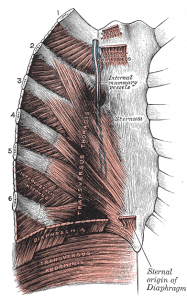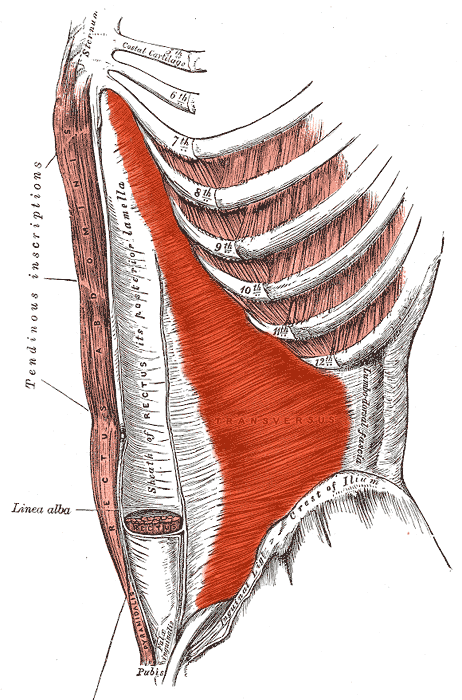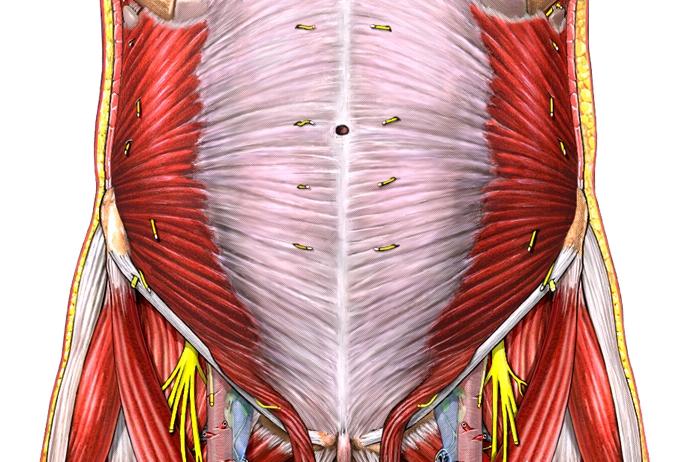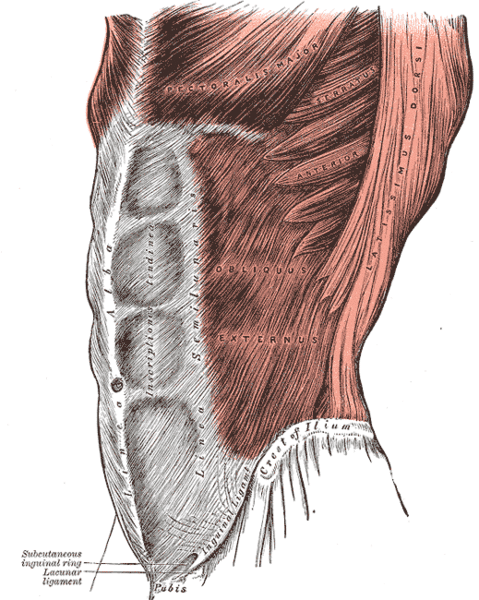The Anatomy of the Abdomen (part 3/4: Transversus Abdominis)
The Transversus Abdominis is the deepest layer of the abdominal wall, underneath the internal obliques. It stabilizes the mid-back and pelvic areas. Since it is the deepest layer of abdominal tissue, its function is important is activating the other muscles of the abdomen and stabilizers in the spine during dynamic movement. It is also implicated in most spinal injuries though the scientific community is in debate about how much effect the muscle has on lower back dysfunction.
The muscle originates in the borderline of the ribs, the front of the hip plate and the inguinal ligament, and the lumbar fascia. It joins the rectus sheath (6 pack muscles outlined in the abdomen) at the front of the abdomen and inserts in the linea alba. It joins at the front of the pubic bone via the conjoint tendon, which often conjoins with the internal oblique, but can also be separated.
The transversus abdominus muscles is also known as the corset  muscle, because it holds in the organs and abdominals. It is innervated, or activated, with T7-T11 and nerves from the hip plate
muscle, because it holds in the organs and abdominals. It is innervated, or activated, with T7-T11 and nerves from the hip plate
and is extremely useful in stabilizing the spine. Its activation is not affected by the arms and it is the primary muscle activated during breathing, making it extremely important to yoga exercises and for life in general. The muscle is activated fairly easily during breathing and can help to ease to movement of breath in the body, making it easier and more efficient for the respiratory system to function.
So lets review all of this information in the light of breathing in yoga. Because the transverse abdominis muscle is the deepest muscle, it is the most used for breathing many anatomists believe for supporting the spine. It is definitely heavily used in conjunction with the oblique muscles to assist the diaphragm in breathing. This is also the muscle that coordinates the others, recruiting the other muscles under heavy strain. This is why setting a breath pace at the beginning of a yoga class is extremely useful; you are setting the muscle memory for your breathing muscles. I like to use breath retention exercises early in the practice to set a tone of slow, and deep breathing, using all of the muscles in connection and concert together.
There is one particular exercise that is amazing for working the transverse abdominis; leg raises with the knees at least in a 90 degree angle. Feet lower to the floor and extend forward as they lower. Lower back stays on the floor and you should inhale the feet to the floor and exhale the knees back up to 90 degrees. Take about 30 repetitions, go as slow as you can while moving with you breath.
Being an important breathing muscle also makes the transverse abdominis an important muscle for the organs and their movement during respiration. We will definitely be revisiting this muscle as I write posts on breathing exercises and yoga poses. Leave a comment if there is anything else about the abdominals you want me to write about in the final post about the rectus abdominis.
The Anatomy of the Abdomen (part 3/4: Transversus Abdominis) Read More »





